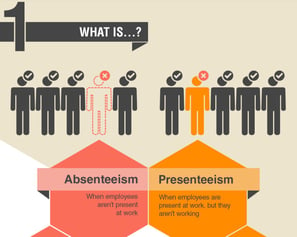Staggering Numbers
Absenteeism, presenteeism, disengagement… We hear these words interchangeably, but they’re not the same. The one thing they have in common? They’re very costly to organizations.
Absenteeism happens when workers don’t show up at work. It may be because of physical health challenges, mental health challenges (stress, anxiety, burnout, depression), or many other potential mental and behavioral health challenges.

The CDC found that the average American worker was absent from work for an average of 4 to 5 days a year, pre-pandemic. We can only assume that these numbers increased during the pandemic, as many workers were quarantined after testing positive to COVID, taking time off to get vaccinated, or fighting the vaccine side effects. There is no relevant data yet on the impact of pandemic-related health issues leading to absenteeism, but we can assume it’s certainly had an impact on absenteeism rates.
Presenteeism refers to situations where employees are there physically, but they’re not there mentally. As Joe Queenan, journalist and commentator, says “presenteeism is a situation that arises when distracted employees drag their forlorn carcasses into the office and waste everyone else’s time by hacking their way through their working day on an empty tank.” It’s what I call Zombie land.
There are many reasons for presenteeism – some of them are identical to the reasons driving absenteeism. Employees come to work but are unproductive on the job due to burnout, harassment, mental illness, demotivation, no chemistry with the team, conflicts, time management, stress, etc. Most, if not all these reasons, are deeply connected to a company’s culture.
The 2015 Global Challenge 100 Day Journey and the World Health Organization (WHO) Workplace Health and Productivity Questionnaire (HPQ) show that absenteeism costs companies about 4 days a year per employee, compared to an even more impressive 57.5 days lost to presenteeism. The cost of presenteeism to businesses also is 10 times higher than absenteeism. Absent workers cost employers around USD $150 billion per year, but those who come to work and are not fully productive cost USD $1,500 billion per year.
Furthermore, beyond the simple cost of days lost due to presenteeism is the increased probability of mistakes that can happen due to the lack of diligence, motivation, even work ethic. For instance, presenteeism causes companies to lose deals or clients, or have team conflicts and negative vibes in the whole department and across teams.
What It Costs Your Company - $$$$$
Absenteeism and presenteeism are the byproduct of employee disengagement.
According to Gallup, disengaged employees have 37% higher absenteeism, 18% lower productivity and 15% lower profitability. When that translates into dollars, you're looking at the cost of 34% of a fully disengaged employee's annual salary, or $3,400 for every $10,000 they make. Multiply this number by 14% of the average workforce that is completely disengaged, plus 50% that are somehow disengaged… See the cost $$$?
According to Gallup, fully disengaged employees make up 14% of the workforce and:
- have 37% higher absenteeism,
- 18% lower productivity,
- 15% lower profitability,
- cost of 34% of a fully disengaged employee's annual salary, or $3,400 for every $10,000 they make.
- add to the 14% number the 50% that are somehow disengaged… See the cost $$$?
Based on CDC, GCC, and EHS estimates, lack of vitality drives presenteeism loss – an “invisible cost” averaging $12,000/employee per year, which is 7 times the cost of absenteeism.
How To Fix It
It’s all about enhancing your culture of caring with CLEAR actions and solutions.
- Create a safe space where it’s OK to show vulnerability (and it starts with the C-suite sharing stories)
- Talk openly about what it’s like to be human at work
- Provide solutions such as LifeGuides that really address the whole person, from struggling at home/work, to building resilience, to developing a positive mindset, and to focusing on personal/professional growth
- Provide solutions for growth (unlike coaching that feels elitist as it is only offered to a handful of employees, LifeGuides is highly affordable and scalable to your entire employee population)
- Create a sense of purpose at the company level, and help individuals define their own purpose in their work, so that they can feel fulfilled at work
- Provide supervisor training centered on empathetic leadership (which LifeGuides provides as part of our client onboarding process)
- Peer-to-peer support with a community of certified Guides, people with real life/work experiences who’ve been in your employees’ shoes before. They know first-hand what your people are going through and are here to help them navigate through these life/work events.
Bonus Video: Meet Sarah, one of our top Guides! By Stephan Vincent, Sr. Director of Workplace Experience, LifeGuides
By Stephan Vincent, Sr. Director of Workplace Experience, LifeGuides
Building amazing company cultures centered around purpose, people-first mindset, human experience, and ❤️ for one another to optimize team performance
Let's Connect on LinkedIn!



